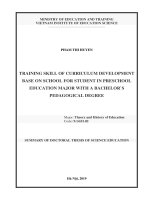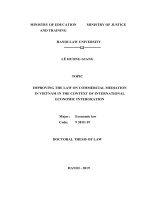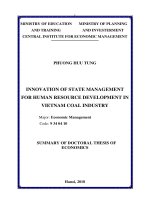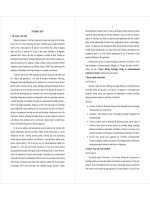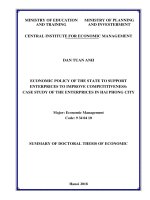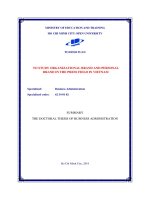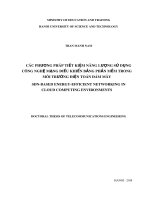Doctoral thesis of philosophy book publishing in australia the potential impact of digital technologies on business models
Bạn đang xem bản rút gọn của tài liệu. Xem và tải ngay bản đầy đủ của tài liệu tại đây (1.94 MB, 383 trang )
BOOK PUBLISHING IN AUSTRALIA:
THE POTENTIAL IMPACT OF DIGITALTECHNOLOGIES
ON BUSINESS MODELS
A Thesis Submitted to RMIT University
for the Degree of Doctor of Philosophy
Xuemei Tian
B. Sc., M. BIT.
JUNE 2008
Declaration
I certify that this thesis contains no material, which has been accepted for the award of any
other academic award in any institution, college or university, and that, to the best of my
knowledge and belief, it contains no material previously published or written by another
person, in whole or in part, except where due reference is made in the text of the thesis. The
content of the thesis is the result of work which has been carried out since the official
commencement date of the approved research program, and, any editorial work, carried out
by a third party is acknowledged.
Xuemei Tian
______________________
Sign
Declaration
______________________
Date
i
Acknowledgement
The person who coined the phrase “no pain, no gain” was obviously in the midst of a PhD
research project when he made the observation. Although the pursuit of a PhD is based on an
individuals’ performance, the demands of the project ensure that there will always be a
support team providing essential support and encouragement. During my time there have been
many who fell into this category, giving both tangible and intangible assistance.
Special thanks to my senior supervisor Professor Bill Martin. It is hard to find the words that
can adequately describe the level of support, guidance and encouragement that he has
provided. His enthusiasm to see me succeed has been a constant source of inspiration. He
provided the academic impetus which enabled my research to reach its conclusion. Amidst the
challenges of supervising numerous students and semi-retirement status, he never failed to
ensure that a constant stream of advice and guidance was never far away. Thanks are due also
to my second supervisor, Associate Professor Hepu Deng for his support and input.
It would be remiss of me if I failed to give a special thank you to Peter Grof, the RMIT
University School Liaison Librarian who provided outstanding support and advice to me in
technical areas of the research. There were also many stakeholders within the Australian
publishing industry who graciously allowed me access to their valuable time, providing me
with invaluable insights into their industry. Their willingness to participate in the research
was greatly appreciated. There are many others, both friends and family who have contributed,
but to name them all is impossible - you know who you are. I cannot thank you enough for
your thoughts and support.
Acknowledgement
ii
There have been many occasions of sacrifice where leisure pursuits have taken a back seat.
My partner Geoff has borne the brunt of these, but has never wavered in his encouragement to
see me complete the project. He was there when the tears flowed, when frustration boiled over
and threats to quit loomed on the horizon. He laughed with me in the good times and consoled
me in the bad times. Surely this is what love is.
Finally, I believe that above all else, you must have faith in your God as it is He that controls
your destiny. I know that in the difficult times God never left my side and when necessary,
carried me. Psalms 121:1-2 says:
I lift up my eyes to the hills
Where does my help come from
My help comes from the Lord
The maker of heaven and earth.
Acknowledgement
iii
Abstract
This research presents findings from an Australian government-funded research project
looking at the implications of digitisation for the book publishing industry in Australia.
Although digitisation is to some extent synonymous with digital technologies and in fact, the
impact of current and emerging digital technologies is clearly central to any such study, the
major focus was on business and organisational dimensions, with particular emphasis on
current and emerging stakeholders, competition, value propositions and business models, both
current and potential.
The publishing industry has always been linked inexorably to the dissemination of knowledge.
Publishing and associated printing activities relied on long-standing and proven old
technologies to provide a definitive linear progression for the creation of content in print form,
providing clear implications for business processes and relationships for the various
stakeholders. The emergence and development of digital technology has the potential to
provide significant opportunities for publishing in both print and electronic formats, and with
advances in electronic commerce, offers the prospect of new value propositions and business
models. New digital publishing formats encapsulate a range of characteristics including
multiple option infrastructures, various content formats and viewing modes designed to suit
customer requirements, editing processes and information updates on the server. These
innovations all contribute to reductions in processing time with the speedy, efficient
transmission of content resulting in economic benefits to relevant stakeholders. However, it
must be remembered that even the latest digital tools and applications can only be viewed as
enabling mechanisms whose acceptance and implementation must align directly with the
business strategy and objectives of organisations.
Abstract
iv
This thesis employed both an interpretive research paradigm, using a mixed methodology
design, and elements of the design science paradigm. The aim was not to develop theories, but
to build business models. The reporting and analysis of results is based on data gathered from
two online surveys, one of publishers and one of end users, and from 14 case studies of
Australian book publishers.
The results indicate that Australian book publishers continue to take a pragmatic approach to
technology adoption, governed by both current market conditions and the failure of earlier
technologies to deliver the anticipated results. Although content management and CRM
technologies are by now ubiquitous, the most influential technologies currently in use in
publishing continue to be the Internet and the World Wide Web. Little explicit interest is
currently being shown in such potentially disruptive technologies as for example, the
Semantic Web, although evidence for its influence can already be detected, however, there is
widespread appreciation of the wider dimension to digitisation and of its potential impacts on
organisational structures and strategies. This includes renewed attention to issues of value,
and of the potential benefits of providing enhanced customer value through digital content and
delivery channels, their consequent implications for changes to value chains, and the
emergence of new and transitional business models.
As regards the case studies, it is important to emphasise that what has been reported here are
five detailed examples drawn from different categories of publishers. Although the resultant
business models depicted can hardly be described as being representative of the Australian
book publishing sector as a whole, the five categories covered represent a significant portion
of the book publishing sector. Furthermore, whatever the category of publishing, or the target
Abstract
v
markets, products and services concerned, it is clear that all book publishers must adhere to
similar stages and processes in building supply and value chains, and in the design of business
models. Moreover, as the influence of customers continues to gain momentum, this will
undoubtedly impact upon choices in all these areas – from partnerships and delivery channels
to formats and value propositions. As an analysis of the case study data has shown, all 14
companies participating in this research project recognised the potential as well as the
inevitability of digitisation, and had embraced the need for new value and supply chains.
This research contributes to the literature both by reinforcing many of the arguments for
trends in book publishing emerging from around the world, and by its uncovering of specific
data on trends in book publishing in Australia and of the implications for value chains and
business models.
Abstract
vi
Table of Contents
DECLARATION .................................................................................................................. i
ACKNOWLEDGEMENTS................................................................................................. ii
ABSTRACT ........................................................................................................................ iv
TABLE OF CONTENTS................................................................................................... vii
LIST OF FIGURES .......................................................................................................... xiv
LIST OF TABLES ........................................................................................................... xvi
LIST OF ABBREVIATIONS......................................................................................... vxiii
LIST OF PUBLICATIONS – BASED ON THIS THESIS .............................................. xx
CHAPTER 1
1.1
1.2
1.3
1.4
1.5
1.6
1.7
CHAPTER 2
INTRODUCTION
Overview.................................................................................................... 1
Research rational ........................................................................................ 3
Research objectives .................................................................................... 4
Research questions ..................................................................................... 5
Research outcomes ..................................................................................... 6
Limitations of the study .............................................................................. 7
Structure of the thesis ................................................................................. 7
DEVELOPMENT OF THE PUBLISHING INDUSTRY
2.1
2.2
2.3
2.4
Introduction.............................................................................................. 10
An overview of the publishing industry .................................................... 11
A brief history of book publishing ........................................................... 14
The book publishing industry ................................................................... 16
2.4.1 Structure ........................................................................................ 17
2.4.2 Key stakeholders in the book publishing industry........................... 19
2.5 Emerging changes in the book publishing industry ................................... 21
2.5.1 External Forces .............................................................................. 23
2.5.1.1 The globalisation of markets and publishing firms ................. 23
2.5.1.2 Mergers and acquisitions ....................................................... 25
2.5.1.3 Technological Changes.......................................................... 26
2.5.1.4 Consumer- demand shifts ...................................................... 35
2.5.1.5 Competition........................................................................... 37
Table of Contents
vii
2.5.1.6 Government policy ................................................................ 38
2.5.1.7 E-books ................................................................................. 39
2.5.1.8 New media ............................................................................ 46
2.5.2 Internal Forces - Actions of top management.................................. 47
2.5.2.1 Outsourcing strategies ........................................................... 48
2.5.2.2 Niche markets........................................................................ 49
2.5.2.3 Structure................................................................................ 50
2.5.2.4 Organisational culture............................................................ 51
2.5.2.5 IT strategies........................................................................... 52
2.6 Digital Publishing..................................................................................... 54
2.7 Book publishing supply and value chains, and value networks.................. 64
2.7.1 Supply chains ................................................................................. 64
2.7.1.1 Book publishing supply chains .............................................. 64
2.7.1.2 Supply chains in digital publishing ........................................ 65
2.7.2 Value chains................................................................................... 66
2.7.2.1 Support activities................................................................... 72
2.7.2.2 Processing activities .............................................................. 74
2.7.3 Value networks in the digital age.................................................... 75
2.8 Conclusion ............................................................................................... 79
CHAPTER 3
3.1
3.2
3.3
3.4
3.5
3.6
CHAPTER 4
4.1
4.2
4.3
BUSINESS MODELS
Introduction.............................................................................................. 80
Overview of business models and e-Business models ............................... 81
3.2.1 Business Model.............................................................................. 82
3.2.2 E-Business models ......................................................................... 84
3.2.3 Key components of business models .............................................. 86
3.2.3.1 Product-Actor and Network-Centric business model
frameworks......................................................................... 86
3.2.3.2 Marketing-specific business model frameworks.................. 89
3.2.4 Business models, business modelling and strategy.......................... 91
The importance of business models .......................................................... 93
3.3.1 Use of business models .................................................................. 95
3.3.2 Business models and change .......................................................... 98
3.3.3 Testing and evaluating business models ......................................... 99
Business models in the publishing industry..............................................100
Business model in digital publishing........................................................104
Conclusion ..............................................................................................112
RESEARCH METHODOLOGY
Introduction .............................................................................................114
Overview of methodology and its selection processes..............................114
The philosophical perspectives of the research.........................................117
4.3.1 Nature of the research....................................................................117
Table of Contents
viii
4.3.2 Philosophical Orientations.............................................................118
4.3.2.1 The positivist paradigm...................................................119
4.3.2.2 The interpretive paradigm ...............................................120
4.3.2.3 The critical realism paradigm..........................................122
4.3.2.4 The design science paradigm ..........................................123
4.4 Rationale for selecting the research methodology ....................................127
4.4.1 The core research methodologies...................................................127
4.4.1.1 Quantitative methods ......................................................128
4.4.1.2 Qualitative methods ........................................................128
4.4.1.3 Mixed methods ...............................................................129
4.4.2 The use of quantitative and qualitative methodologies in interpretive
research.........................................................................................133
4.5 The methodological approach of this thesis..............................................135
4.5.1 Purpose of research – descriptive and exploratory .........................135
4.5.2 Philosophical orientation – interpretive and design science............136
4.5.3 Methodology – A mixed approach.................................................137
4.5.4 Research strategy model – Concurrent nested strategy...................141
4.6 Conclusion ..............................................................................................142
CHAPTER 5
RESEARCH DESIGN
5.1
5.2
Introduction.............................................................................................143
Overview of data collection methods .......................................................143
5.2.1 Literature review ...........................................................................144
5.2.2 Data collection methods for quantitative research..........................144
5.2.3 Data collection methods for qualitative research............................145
5.2.3.1 Case Studies ...................................................................145
5.2.3.2 Ethnographic and phenomenological studies...................148
5.3 Data collection, management and analysis methods in this thesis.............149
5.3.1 Sampling.......................................................................................149
5.3.2 Literature review ...........................................................................150
5.3.3 Data collection methods – Surveys ................................................150
5.3.3.1 Survey design and data collection ...................................151
5.3.3.2 Target populations ..........................................................152
5.3.3.3 Data encoding for the results of both surveys ..................153
5.3.3.4 Descriptive analysis of responses to the end user survey .153
5.3.3.5 Statistical analysis for the end user survey ......................154
5.3.4 Data collection methods – Case study............................................155
5.3.4.1 Case study design ...........................................................156
5.4 Procedures...............................................................................................160
5.4.1 Interview guide .............................................................................160
5.4.2 Selection and description of cases and participants ........................161
5.4.3 Selection and description of survey populations ............................161
5.4.4 Ethical issues.................................................................................162
5.4.5 Reliability and validity ..................................................................163
5.4.5.1 Reliability .......................................................................163
5.4.5.2 Validity...........................................................................165
Table of Contents
ix
5.5
CHAPTER 6
6.1
6.2
6.3
6.4
6.5
6.6
6.7
6.8
6.9
CHAPTER 7
5.4.6 Case study quality control .............................................................167
Conclusion ..............................................................................................168
KEY FINDINGS FROM TWO ONLINE SURVEYS
Introduction.............................................................................................169
Surveys responses, reliability and validity ...............................................169
6.2.1 Responses from the survey of publishers .......................................169
6.2.2 Responses from the survey of end users ........................................170
6.2.3 Survey Reliability and Validity .....................................................170
General book publishing trends ...............................................................171
6.3.1 Revenue growth ............................................................................171
6.3.2 Media channels .............................................................................172
6.3.3 Outsourcing practices ....................................................................172
6.3.4 Current possession of critical success factors.................................173
Markets, supply chains and value chains..................................................174
6.4.1 Competition ..................................................................................174
6.4.2 Supply chain issues .......................................................................175
6.4.3 Value chain changes......................................................................175
Digitisation and business models .............................................................177
6.5.1 Anticipated benefits of digitisation ................................................177
6.5.2 Critical success factors for digital business models........................177
6.5.3 Current business models................................................................178
Expectations of the Future .......................................................................179
6.6.1 Areas where digitisation was expected to have most impact ..........179
6.6.2 Organisational changes anticipated................................................180
End user behaviour ..................................................................................180
6.7.1 Access to and use of digital technologies and electronic resources.181
6.7.2 Factors influencing use of digital technologies and online resources183
6.7.3 Expectations for the future ............................................................184
6.7.4 Relationship analyses ....................................................................185
Summary of the findings .........................................................................202
Conclusion ..............................................................................................207
CASE STUDIES: BOOK PUBLISHERS IN AUSTRALIA
7.1
7.2
7.3
Introduction.............................................................................................208
The case study companies and quality control in case studies ..................209
Background, general position and trends..................................................211
7.3.1 Current position of the Australian book publishing sector..............212
7.3.2 Key trends in the Australian book publishing sector ......................218
7.4 Position of general trade publishers .........................................................221
7.4.1 Company backgrounds ..................................................................221
7.4.2 Products, services and value propositions ......................................222
7.4.3 Customer base...............................................................................225
7.4.4 Corporate information technology management ............................225
Table of Contents
x
7.5
7.6
7.7
7.8
7.9
7.10
7.4.5 Relationship management..............................................................228
7.4.6 Distribution channels.....................................................................230
7.4.7 Financial aspects ...........................................................................231
7.4.8 Value chains and business models .................................................233
7.4.9 Risks, opportunities and the future.................................................236
Position of educational publishers............................................................238
7.5.1 Company backgrounds ..................................................................239
7.5.2 Products, services and value propositions ......................................240
7.5.3 Customer base...............................................................................242
7.5.4 Corporate information technology management ............................242
7.5.5 Relationship management..............................................................246
7.5.6 Distribution channels.....................................................................248
7.5.7 Financial aspects ...........................................................................249
7.5.8 Value chains and business models .................................................250
7.5.9 Risks, opportunities and the future.................................................252
Position of professional publishers...........................................................253
7.6.1 Company backgrounds ..................................................................253
7.6.2 Products, services and value propositions ......................................254
7.6.3 Customer base...............................................................................257
7.6.4 Corporate information technology management ............................257
7.6.5 Relationship management..............................................................260
7.6.6 Distribution channels.....................................................................262
7.6.7 Financial aspects ...........................................................................263
7.6.8 Value chains and business models .................................................264
7.6.9 Risks, opportunities and the future.................................................267
Position of specialist publishers ...............................................................268
7.7.1 Company backgrounds ..................................................................269
7.7.2 Products, services and value propositions ......................................270
7.7.3 Customer base...............................................................................273
7.7.4 Corporate information technology management ............................273
7.7.5 Relationship management..............................................................276
7.7.6 Distribution channels.....................................................................278
7.7.7 Financial aspects ...........................................................................279
7.7.8 Value chains and business models .................................................279
7.7.9 Risks, opportunities and the future.................................................283
Position of university presses...................................................................286
7.8.1 Company backgrounds ..................................................................286
7.8.2 Products, services and value propositions ......................................287
7.8.3 Customer base...............................................................................289
7.8.4 Corporate information technology management ............................290
7.8.5 Relationship management..............................................................292
7.8.6 Distribution channels.....................................................................295
7.8.7 Financial aspects ...........................................................................296
7.8.8 Value chains and business models .................................................297
7.8.9 Risks, opportunities and the future.................................................300
Comparing the categories ........................................................................302
Conclusion ..............................................................................................305
Table of Contents
xi
CHAPTER 8
8.1
8.2
8.3
8.4
8.5
8.6
8.7
8.8
CHAPTER 9
9.1
9.2
9.3
9.4
9.5
9.6
DEVELOPMENTS IN BOOK PUBLISHING IN AUSTRALIA
Introduction.............................................................................................306
External forces.........................................................................................306
8.2.1 Globalisation, mergers and acquisitions.........................................306
8.2.2 Technological changes ..................................................................307
8.2.2.1 Disruptive technologies...................................................308
8.2.2.2 Workflow, content and digital asset management............310
8.2.2.3 Blogging, podcasts and communities ..............................311
8.2.3 E-books.........................................................................................312
8.2.4 Shifts in customer demand ............................................................314
8.2.5 Competition ..................................................................................315
8.2.6 Government polices.......................................................................316
8.2.7 New media ....................................................................................316
Internal forces..........................................................................................317
Supply chains, value chains and value networks ......................................321
E-business issues emerging in the interviews ...........................................324
Business models ......................................................................................324
Evaluation of business models .................................................................329
Conclusion ..............................................................................................332
CONCLUSION
Introduction.............................................................................................333
The key findings of the research ..............................................................333
9.2.1
Research question one: What are the major trends emerging within
the Australian book publishing industry? ....................................333
9.2.2
Research question two: How do current and emerging business
models compare with regard to scope, design and structure?.......335
9.2.3
Research question three: What technologies and applications offer
the greatest potential for supporting value creation activities and
business model development in the digital era? ..........................337
Contrasts between the research findings and the literature........................338
Summary of the findings..........................................................................338
Contribution of this research....................................................................340
Research limitations and directions for future research ............................341
REFERENCES ................................................................................................................343
APPENDIX A: Media consumer spending and their usage ..........................................360
APPENDIX B: Digital technologies................................................................................361
APPENDIX C: Survey questionnaire to publishers.......................................................362
APPENDIX D: Survey questionnaire to end users ........................................................370
Table of Contents
xii
APPENDIX E: Statistic analysis variables used in SPSS ..............................................375
APPENDIX F1: Different age groups with the use of information technologies............378
APPENDIX F2: Different groups in the university and use of electronic resources......379
APPENDIX F3: Different age groups and degree usage of electronic resources ...........380
APPENDIX F4: Different groups in the university and their online activities ..............381
APPENDIX F5: Different age groups and their online activities....................................382
APPENDIX F6: Online activities and developments in multi-function devices .............383
APPENDIX F7: Online activities and developments in content format conversion
technology ..............................................................................................384
APPENDIX G1: Company P3 profit and loss model for adult trade paperbound book
(Profitable) ............................................................................................385
APPENDIX G2: Company P3 profit and loss model for adult trade hardbound (cloth)
book (non-profitable) ............................................................................387
APPENDIX H1: Company P1 Profit report.....................................................................389
APPENDIX H2: Company P4: Model for a textbook (Revised P&L for 3 years)..........391
APPENDIX H3: Company P4 profit report.....................................................................393
APPENDIX H4: Australian parent group (including Company P5) profit report.........395
APPENDIX H5: Australian parent group (including Company P8) profit report.........397
APPENDIX H6: Company P14’s traditional book profit and loss model in 2004 ..........399
Table of Contents
xiii
List of Figures
Figure 2.1: Framework of vertical relationships.................................................................. 19
Figure 2.2: Major external and internal forces .................................................................... 22
Figure 2.3: Technologies and types of publishing............................................................... 35
Figure 2.4: The proportion of the market split by genre and changes .................................. 62
Figure 2.5: The growth of digital versus physical formats................................................... 63
Figure 2.6: Trends in globalisation and digitisation ............................................................ 63
Figure 2.7: A traditional supply chain for book publishing ................................................. 65
Figure 2.8: An initial view of ongoing changes on the publishing supply chain .................. 65
Figure 2.9: An optimum digital publishing supply chain model .......................................... 66
Figure 2.10: An example of value chain model..................................................................... 68
Figure 2.11: A value chain model for a book publishing....................................................... 72
Figure 2.12: Value network.................................................................................................. 76
Figure 2.13: A potential value network for book publishing ................................................. 78
Figure 3.1: Business layers................................................................................................. 92
Figure 3.2: Environment, business models, strategy, process and information systems ....... 93
Figure 3.3: Porter-style activity system map for a publishing company..............................102
Figure 3.4: The Lonely Planet e-Business model schematic...............................................102
Figure 3.5: Michael Porter’s five forces model ..................................................................107
Figure 3.6: Six components of the new business model .....................................................108
Figure 3.7: A scenario-based methodology for business model change ..............................109
Figure 4.1: The research framework of this thesis..............................................................116
Figure 4.2: Design science research framework.................................................................125
Figure 4.3: Design science research cycle..........................................................................126
Figure 4.4: Research outline for this thesis ........................................................................138
Figure 4.5: Method mix for the thesis ................................................................................139
Figure 5.1: Types of case studies.......................................................................................146
Figure 6.1: Outsourcing areas in book publishing in Australia...........................................173
Figure 6.2: Competition experienced in the past five years 2001 to 2006...........................174
Figure 6.3: Potential benefits of digital publishing.............................................................177
Figure 6.4: Business models in current use ........................................................................179
List of Figures
xiv
Figure 7.1: A technology map of the book industry in Australia ........................................216
Figure 7.2: Real growth of industry revenue in 2002 – 2007..............................................220
Figure 7.3: Content licensing model ..................................................................................233
Figure 7.4: Full service business model .............................................................................234
Figure 7.5: Aggregated model: E-book creation ................................................................234
Figure 7.6: A subscription, site license and licensing data models .....................................235
Figure 7.7: A subscription model and a cooperative model................................................235
Figure 7.8: Content creation model....................................................................................250
Figure 7.9: The cooperative model for outsourcing editing ................................................251
Figure 7.10: A full service model for printing......................................................................251
Figure 7.11: A model of selling through company’s representatives ....................................251
Figure 7.12: The information collection and creation model ................................................264
Figure 7.13: Outsourcing and content processing/management model .................................265
Figure 7.14: Cooperative (outsourcing and distribution) model ...........................................265
Figure 7.15: A syndication model .......................................................................................266
Figure 7.16: A subscription model and online promotion model..........................................266
Figure 7.17: The content licensing and the cooperative model.............................................280
Figure 7.18: E-book creation and cooperative model...........................................................280
Figure 7.19: A multi-printing and multi-delivery formats model .........................................281
Figure 7.20: Multi-online-distribution model and aggregation models.................................281
Figure 7.21: A self-publishing model ..................................................................................297
Figure 7.22: A content creation model ................................................................................297
Figure 7.23: A outsourcing model and a cooperative model ................................................298
Figure 7.24: Aggregation and cooperative models...............................................................298
Figure 7.25: POD and online-to-customer models...............................................................299
Figure 8.1: Digital book publishing supply chain model ....................................................321
Figure 8.2: Life cycles of value creation in digital publishing business models..................323
Figure 8.3: A generic book publishing model ....................................................................327
Figure 8.4: A potential generic model for e-book publishing .............................................328
Figure 8.5: Application of the Design Science paradigm to the research ............................331
List of Figures
xv
List of Tables
Table 2.1: Interactions among the various parties involved in book publishing ................. 20
Table 3.1: Business model authors list .............................................................................. 81
Table 3.2: Categories of digital business models and examples ......................................... 85
Table 4.1: Purpose of research .........................................................................................118
Table 4.2: The basic assumptions of positivism and interpretivism...................................121
Table 4.3: A summary of the differences between positivism and interpretivism..............121
Table 4.4: Decision choices for determining a mixed methods strategy of inquiry............131
Table 4.5: Fundamental differences and distinctions between methodologies...................132
Table 5.1: Data collection methods ..................................................................................143
Table 5.2: Crosstabulation Statistical analysis employed in this Survey (SPSS)...............155
Table 5.3: Types of reliability and their characteristics.....................................................163
Table 5.4: Types of validity and their characteristics and comments.................................166
Table 6.1: Reliability and validity of the questions in the two surveys..............................171
Table 6.2: Critical success factors currently possessed by companies ...............................173
Table 6.3: Supply chain issues that cause problems for companies...................................175
Table 6.4: Players in book publishing value chains that are at risk of disintermediation....176
Table 6.5: Major stakeholders in the emerging value chains for digital publishing ...........176
Table 6.6: Success factors for digital business models......................................................178
Table 6.7: Areas to be most likely to be affected by the impact of digital publishing ........179
Table 6.8: Perceived changes in the book publishing industry in Australia .......................180
Table 6.9: Frequency of use of electronic resources .........................................................182
Table 6.10: Frequently of engagement in online activities..................................................182
Table 6.11: Reasons why people use digital technology and electronic resources and
purchase online...............................................................................................183
Table 6.12: Factors acting to discourage the use of electronic resources or online
purchasing.......................................................................................................183
Table 6.13: Technologies expected to have most impact on digital publishing ...................184
Table 6.14: Where technology development is impacting most on digital publishing .........185
Table 6.15: Different roles in the university with differences in levels of use of
information technologies ................................................................................186
List of Tables
xvi
Table 6.16: Different roles in the university with different levels of use of digital devices .186
Table 6.17: Statistical test on the differences shown in table 6.16.......................................187
Table 6.18: Different roles within the university and access to electronic resources ...........189
Table 6.19: Statistical test on the differences shown in table 6.18.......................................189
Table 6.20: Statistical test of the differences between different groups in the university
and the use of electronic resources..................................................................191
Table 6.21: Different age groups in the university and access to electronic resources .........192
Table 6.22: Statistical test on the differences shown in table 6.21.......................................192
Table 6.23: Statistical test of the difference between age groups and the use of electronic
resources ........................................................................................................194
Table 6.24: Statistical test of the difference between university groups and their
behaviour as regards online activities..............................................................196
Table 6.25: Statistical test of the differences of age groups and their behaviour as
regards online activities ..................................................................................198
Table 6.26: Statistical test of the relationship between developments in multi-function
devices and online activities ...........................................................................199
Table 6.27: Statistical test of the relationship between developments in content format
conversion technology and online activities ....................................................201
Table 6.28: Summary of relationship analysis ...................................................................205
Table 7.1: Quality control in cases: tests, tactics and actions ............................................209
Table 7.2: Market share of publishing in 2003, 2005, 2006 and 2007 in Australia ............213
Table 8.1: Key elements of business model comparison...................................................329
List of Tables
xvii
List of Abbreviations
AAP
The Association of American Publishers
ABS
Australian Bureau of Statistics
APA
Australian Publishing Associate
B2B
Business to Business
B2C
Business to Customer
D-books
Digital Books
DOI
Digital Object Identifier
DRM
Digital Rights Management
CAL
The Copyright Agency
CSFs
Critical Success Factors
CSS
Cascading Style Sheets
CTO
Chief Technical Officer
E-books
Electronic Books
EDI
Electronic Data Interchange
EVDO
Evolution-Data Optimized
ICTs
Information and Communication Technologies
MIME
Multipurpose Internet Mail Extensions
MPEG
Moving Picture Experts Group
NAICS
The North American Industrial Classification System
OEBPS
Open eBook Publication Structure
ONIX
Online Information Exchange
PDA
Personal Digital Assistant
Portable Document Format
PC
Personal Computer
POD
Print-on-Demand
PSPs
Play Station Portables
List of Abbreviations
xviii
P2P
Peer to Peer
RDF
Resource Description Framework
SGML
Standard Generalized Markup Language
STM
Science, technology and medicine
URI
Uniform Resource Identifier
UML
Unified Modeling Language
VOD
Video-on-Demand
W3C
World Wide Web Consortium
XHTML
The Extensible Hypertext Markup Language
XML
eXtensible Markup Language
List of Abbreviations
xix
List of Publications – Based on This Thesis
Refereed Journal Article:
Tian X, Martin B and Deng H (2008). The impact of digitization on business models for
publishing: Some indicators from a research project. Journal of Systems and Information
Technology , Volume 10, Issue 3
Refereed Conference Papers:
Martin B, Deng H, Tian X, and Byrne J (2006). Knowledge management and publishing: the
role of intangibles in digital supply chains. Proceedings of the International Conference
on Business Knowledge Management, 24-26 October, Macao.
Martin B, Deng H and Tian X (2007). Expectation and Reality in Digital Publishing: Some
Australian Perspectives. Proceedings of the ELPUB2007 Conference on Electronic
Publishing, June 8-12, Vienna, Austria.
Martin B, Tian X, and Deng H (2007). E-Commerce in Digital Publishing: Some Indicators
from A Research Project. Proceedings of the IADIS International Conference e
Commerce, December 7-9, Portugal.
Martin B, Tian X, and Deng H (2007). Technology and Publishing: Developments in Digital
Publishing in Australia. Proceedings of the IASK International Conference E Activity and
Leading Technologies, December 3-6, Portugal.
Tian X, and Martin B (2008). Value chains and e-Business models in Australian book
publishing. Proceedings of the IADIS International Conference on e-Commerce, July 2527, Amsterdam, Netherlands (Forthcoming).
List of Publications – Based on This Thesis
xx
Chapter 1 Introduction
1.1
Overview
Australia’s publishing industry represents a highly significant manufacturing and distribution
component of the content industry, creating, transferring and storing knowledge. IBISWorld
(2008) statistics show that the publishing industry’s value increased at an average annual rate
of 3.1% for the five year period to 2007-08.
Over the past decade, the publishing industry has undergone tremendous changes including:
•
Movement from traditional general publishing markets into more specialist areas such
as those for professional, educational, and scholarly communities (Cope and Mason,
2001; Cheng, 2004). This move has catered to the requirements of specialist areas,
and the production of a variety of publications in book and other formats (Ronte,
2001).
•
Increased digital content formats producing dramatic increases in revenue from online
business.
•
Implementation of changes to distribution channels and supply chains. Most
companies now have their own web pages and use them to communicate with authors
and service end-users directly.
•
Increased levels of outsourcing, and sub-contracting of various processes. This has
encouraged the creation and development of new businesses, but also has resulted in a
more competitive marketplace.
These changes have predominantly occurred owing to the rapid growth and development of
technologies, a turbulent business environment, the growth of global concentrates, increased
Chapter 1 Introduction
1
competition, stakeholders’ demands for improved financial performance and more
sophisticated customer requirements (Scupola, 1999; Davis and Walter, 2003; Lanza, 2004).
To cope with these changes, publishers have had to re-evaluate their resources and
capabilities, to design new business strategies and to re-engineer their business processes.
This has led to the development of new supply chains in the publishing industry, and to a
search for new streamlined business models (IBISWorld, 2004; IBISWorld, 2006).
Developments in technology have included advances in applications and digital networks,
including technologies for e-commerce and specific developments such as e-books, rights
management technology and digital print-on-demand technologies. Although the publishing
industry has adopted a conservative approach regarding take-up of these technologies,
publishers have largely accepted the inevitability of digital technology on the basis that:
•
Digital technology has no boundaries in geography and time and its advance is
inexorable.
•
Physical distribution channels have changed;
•
Additional copies can be produced at marginal cost;
•
New intermediaries are appearing (non-traditional);
•
Unique content assumes a greater role, such as exclusive access, editorial enhancement
and authority, exclusive distribution, timing and electronic security (Ronte, 2001).
The adoption of digital technology provides opportunities to re-engineer publishing value
chains to ensure maximum benefits for both participants and customers. The implementation
of digital technologies and processes, therefore, carries implications for existing business
models. Consortia of learned societies, libraries and not-for-profit publishers have already
Chapter 1 Introduction
2
formulated or are in the process of formulating new Open Access business models, largely in
the field of scholarly journals. This is in response to both spiralling subscription costs and
unrelenting demand from academics for outlets for their research. The prime purpose of these
models is to allow end-users to access or download articles and information without cost.
Mainstream publishers need to be aware of these developments, and of any implications for
competition or collaboration, as they review the potential of new generation business models
for digital publishing. Open Access models did not feature in the plans of any of the case
companies in this research.
This research aims to gain insights into the book publishing industry in Australia. It will
endeavour to identify and examine book publishing trends, value chains, technologies and
business models, as the book publishing industry contemplates the shift from traditional
production and distribution processes to those facilitated by digital technologies. Additionally,
the research will identify the importance of emerging issues in technology implementation,
and the implications and consequences of the application of these technologies to digital
publishing. By identifying the strengths and weaknesses of digitally-enabled processes, the
research will be useful to companies, seeking both to embrace the new technology and to
adapt existing procedures to the demands of digital publishing. Drawing on the literature and
in particular, on the perceptions of key players and the industry at large, the research will
provide clarification and explanation of the relationships between technology, value chains
and business models.
1.2
Research rationale
Whilst acknowledging that digital publishing has attracted the interest of the book publishing
industry, the literature review reveals a need for further research into the transitional phase
from traditional to digital publishing as:
Chapter 1 Introduction
3
•
There is neither a dominant trend of digital publishing nor any detailed analysis of its
limitations and challenges in the Australian book publishing industry.
•
Although significant new technologies are available to publishers, there are no clear
guidelines regarding their selection and implementation.
•
Digital technologies such as semantic technology, print-on-demand and e-books are
predicted to have a profound effect on publishing, but are yet to impact seriously on
the industry.
•
With the emerging transition from traditional to digital-based processes, business
models will need to be revised to encompass new value –adding processes as supply
chains and value chains undergo change. However, there is still no general consensus
on a business model or framework which can be proposed to commercial publishers.
1.3
Research objectives
Although there has been a sizeable body of research directed towards the study of electronic
publishing, web publishing and digital publishing in general, it lacks a coherent focus and
reflects no clear distinction between digital, web and electronic publishing. Furthermore, in
reviewing the literature of digital publishing, it is apparent that there have been few
comprehensive studies of this subject. This is also the case with the business model literature
in general, and of digital business models in particular. This research seeks to add to the
literature of publishing and digital publishing by reviewing current trends and developments
in the book publishing in Australia, assessing aspects of its future as illustrated by emerging
value propositions, value chains, technologies and business models and not least, by
perceptions of the industry’s future. More specifically, the study’s objectives are as follows:
• Clarification of the field of digital publishing and its key characteristics.
Chapter 1 Introduction
4
